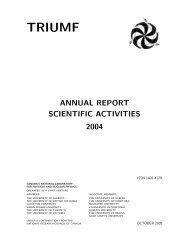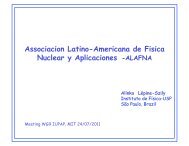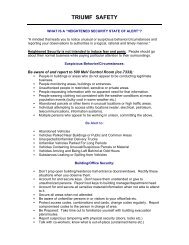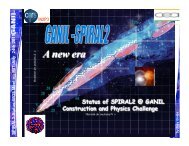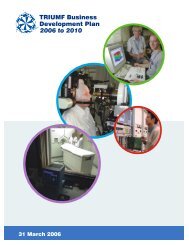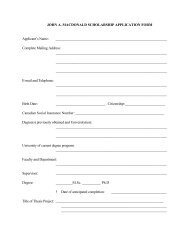TUDA @ ISAC-II Ethanol Handling and Procedures
TUDA @ ISAC-II Ethanol Handling and Procedures
TUDA @ ISAC-II Ethanol Handling and Procedures
- No tags were found...
You also want an ePaper? Increase the reach of your titles
YUMPU automatically turns print PDFs into web optimized ePapers that Google loves.
<strong>Ethanol</strong> use at <strong>TUDA</strong>compressed air, <strong>and</strong> the internal lines are regularly replaced for every experiment, thusthe installation life is not long enough to allow the lines to become brittle.Every internal experimental plumbing setup is tested in vacuum before we accept beam.We pump down to turbo pump vacuum,
<strong>Ethanol</strong> use at <strong>TUDA</strong>• If the chamber was being pumped by the cryo-pump alone, no ethanol could getinto the backing system because the cryo-pump is not connected to the backingsystem when operating.• Venting a chamber filled with ethanol fumes because of a leak does not constitutean ignition hazard because:o The ethanol-air mixture produced inside the chamber will not ignitebecause all electrical equipment inside the chamber is turned off during avent.o Once the chamber flanges are opened any ethanol-air combustible mixturewould quickly be made harmless by dispersal into the large <strong>ISAC</strong>-<strong>II</strong> hall.The pump down scenarioThe only time there would be a significant ethanol safety issue is a catastrophic failurewhile pumping down <strong>TUDA</strong> via the roughing port. There is air still in the chamber <strong>and</strong>an ethanol-air mixture would be directly connected to the scroll roughing pump. Howeverthere is no immediate danger. All electrical devices inside the chamber are off, <strong>and</strong> theconstruction of the scroll pump with its Teflon surfaces will not generate a spark. Thedanger occurs in that a flammable air-ethanol mixture could build up in the <strong>ISAC</strong>-<strong>II</strong> hallvacuum exhaust system. This is unlikely because of these considerations:• The chiller is turned off. Without the positive pressure from the chiller pumpingfluid through the chamber there is almost no chance of popping a connectionleading to a catastrophic leak.• All pump downs via the roughing port occur under watchful eyes of the personoperating the h<strong>and</strong> valve looking at the visual Bourdon pressure gauge. The h<strong>and</strong>valve controls the rate at which the pressure drops in order not to damage verydelicate equipment inside the chamber. If there are any problems, such as thepressure rising or liquid ethanol in the Bourdon gauge (see the appendix 1), theprocedure is to close the h<strong>and</strong> valve <strong>and</strong> investigate. The leak would then becontained inside the <strong>TUDA</strong> chamber.• In addition to looking at the Bourdon gauge <strong>and</strong> operating the h<strong>and</strong> valve, a stripchart will be running <strong>and</strong> visible on the tuda2 monitor. Any pressure excursionseen on the CG5 convectron gauge 3 will result in the pump down person closingthe RV5 valve 4 immediately. That will contain the leak in the chamber.Conclusion <strong>and</strong> improvementsThe conclusion of the above analysis is that the current systems <strong>and</strong> procedures in placeat <strong>TUDA</strong> h<strong>and</strong>le the ethanol coolant in a safe manner as to not present a personnel orequipment hazard. However as with all systems an analysis does lend itself for suggestingpossible improvements to both systems <strong>and</strong> procedures. Hence the following will beimplemented:1. initiate a two person pump down, one person to operate the h<strong>and</strong> valve <strong>and</strong>observe the visual Bourdon gauge, the other to observe the strip chart <strong>and</strong> closeRV5 if there is a pressure excursion.3 CG5 measures directly the vacuum pressure inside the <strong>TUDA</strong> chamber. See the <strong>TUDA</strong> Vacuum System,SEBT1 on the tuda-tactic wiki.4 For the location of RV5 see <strong>TUDA</strong> Vacuum System, SEBT1 on the tuda-tactic wiki.Page 3 of 5
<strong>Ethanol</strong> use at <strong>TUDA</strong>2. have EPICS install an alarm to alert the <strong>TUDA</strong> people on shift of a turbo or acryo-pump gate valve trip, indicators of an ethanol leak.3. Install inlet port <strong>and</strong> outlet port valves on the coolant lines that will limit theamount of ethanol that can be leaked into the chamber when the coolant is notneeded. If valves are installed they will be closed when the chiller is off, <strong>and</strong> onlythe ethanol inside the cooling lines inside the chamber will be dumped in theevent of a leak. This is a small quantity of ethanol <strong>and</strong> will be insufficient to makethe ethanol-air mixture in the <strong>ISAC</strong>-<strong>II</strong> exhaust line explosive. If the coolant is notbeing used, there is no need to have the possibility of dumping the chiller contentsinside the chamber.4. When the chiller is not in use for long periods of time, it will be turned off, <strong>and</strong>the 208-230V/60 Hz/8A AC socket will be switched off <strong>and</strong> locked out.5. The chamber will be vented with dry nitrogen. It was st<strong>and</strong>ard procedure when<strong>TUDA</strong> was in <strong>ISAC</strong>-I, but for some reason the system was disassembled <strong>and</strong> thebottle of nitrogen removed prior to the move to <strong>ISAC</strong>-<strong>II</strong>. It will be re-establishedas soon as there is time to do it. If there was a significant ethanol leak, ventingwith nitrogen will not produce an explosive mixture.Finally it should be noted that since June 2004 leaving the chiller on <strong>and</strong> in operationunattended has been forbidden as st<strong>and</strong>ard <strong>TUDA</strong> operational procedure.Page 4 of 5
<strong>Ethanol</strong> use at <strong>TUDA</strong>APPENDIX 1The <strong>Ethanol</strong> leak of May 7, 2009An assessment of the interlock system to contain an ethanol hazardThe interlocks were tested on May 7, 2009, during a test of the integrity of the coolantplumbing. When the chiller was turned on, the increased pressure to drive the fluidcaused a tube to come out of its swagelok fitting <strong>and</strong> spray ethanol everywhere. The turbopump shut off immediately <strong>and</strong> the backing valve closed. <strong>Ethanol</strong> filled the chamber untilthe chiller was shut down. This did not constitute a safety hazard as there was no oxygeninside the chamber to allow the ethanol to ignite. Liquid ethanol was visible on the faceof the visual Bourdon pressure gauge.The pressure in the backing system never got above a few torr <strong>and</strong> soon fell back down to~8 mtorr. Thus no liquid ethanol made its way to the scroll pump <strong>and</strong> there was nopossibility that the ethanol fumes which were passed through the scroll pump could haveignited. The ethanol concentration was not high enough.This leak was a worse case scenario <strong>and</strong> the vacuum <strong>and</strong> interlock system were sufficientto prevent any possibility for an ethanol ignition. The most hazardous part of this eventwas in venting the chamber which was full of ethanol. In this case the ignition hazard wasminimal because all electronics <strong>and</strong> electrical equipment which could generate a sparkwere off because of st<strong>and</strong>ard <strong>TUDA</strong> procedure, <strong>and</strong> once opened the ethanol fumesquickly dispersed into the large <strong>ISAC</strong>-<strong>II</strong> hall.APPENDIX 2<strong>Ethanol</strong> References• A generic power point presentation on the properties of ethanol, its uses, itsmanufacture, <strong>and</strong> safety measures needed to h<strong>and</strong>le it• The MSDS (Material Safety Data Sheet) on ethanol from Fisher ScientificCorporationPage 5 of 5


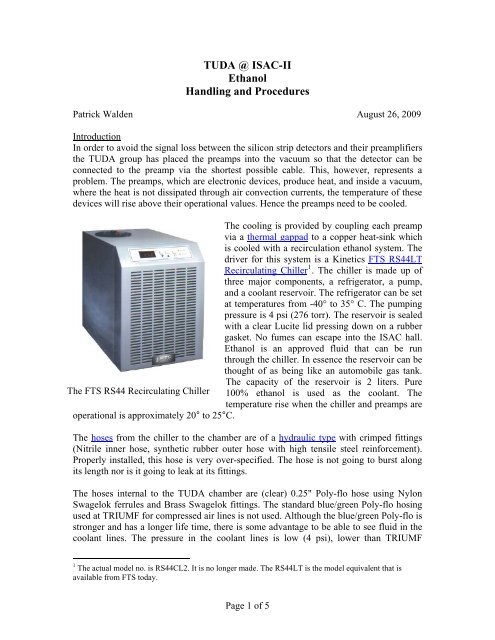
![[124I]Iodine-Ã-CIT](https://img.yumpu.com/51158018/1/190x143/124iiodine-a-cit.jpg?quality=85)
